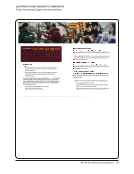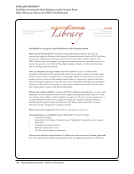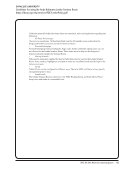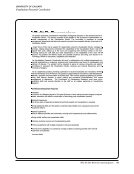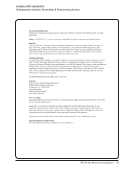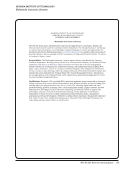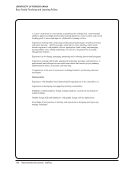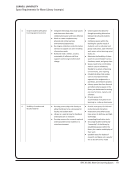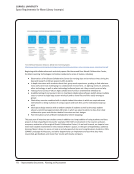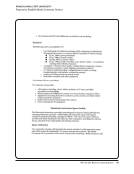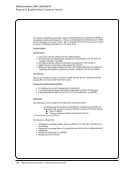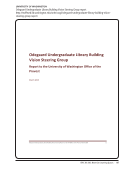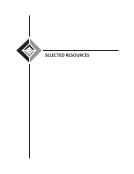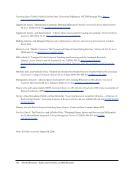84 · Survey Results: Survey Questions and Responses
The next-gen learning spaces have arrived. The next frontier relates to the programming and instructional opportunities
that can be developed around them—for faculty and for students. These spaces provide the infrastructure and offer the
opportunity to build new course-integrated instruction partnerships with faculty, using the research skills/knowledge
of librarians coupled with the technologists and learning specialists we are bringing in. Programming opportunities that
introduce the hardware/software/apps, but more importantly the learning opportunities, digital scholarship, and new
ways of exploring and sharing new knowledge will be the challenge.
The role of next-gen learning spaces act to bring learners and researchers into research libraries. This will push research
libraries to consider their mix of staffing in support of the programs and services that are envisioned.
These spaces will continue to experience flexible evolution along with ongoing changes we see in information
technologies, learning and teaching style preferences, and the overall organizational transitions being experienced
within 21st century academic libraries and within higher education generally. The most successful next-gen spaces will
not only allow for flexible physical implementations over time, but will continue to grow away from mere aggregations
of fixed stand-alone technology or passive service point options. In this sense, as with both online social media
platforms of the recent past and the longer evolutions of library instruction and even longer evolutions of library
collections themselves, such developments arise from an intellectual and organizational legacy of engagement with
source material and spaces that is far deeper than any one media format or spatial design practice. Research libraries,
therefore, will likely see greater intentional linkages put into place that tie such evolving flexible library spaces to
legacy collections, in order to form specific knowledge enhancing feedback loops, all working toward an aim of
greater likelihood that scholars and students inhabiting the spaces will arrive at meaningful research and learning
outcomes. Thus, we may likely see continued efforts to more intentionally tie spaces to specifically desired human
or organizational expertise. Those collections and expertise may be local, regional, or global. The most creative new
deployments of next-gen spaces will also continue to strike a delicate balance between the priorities for allocation of
open available multi-purpose spaces, on the one hand, and intentionally scheduled/intentionally purposed spaces.
Learning styles vary widely, as do research cultures within different disciplines, and the higher end next-gen learning
environments will need to serve those differences while not sacrificing the valuable role of research libraries as open
multidisciplinary communities.
These will be technologically sophisticated learning and research environments that will inspire individual and
collaborative knowledge building using current technologies, tools, and methodologies. Expert staff will assist students
and researchers across the disciplines in a variety of services that meet their changing needs, including digital imaging,
project design and implementation, copyright and fair use, data curation and management, archiving and repository
services, digital scholarship methodologies and practices, as well as the delivery and dissemination of digital content.
Services will be offered as hands-on training, support for small group projects, consultation on project scoping/
planning/management, assistance with data presentation and visualization, and in other ways as needed.
These will become valued community spaces that allow a variety of interactions and scholarship to take place, formally
and informally.
They are collaborative, flexible, high tech spaces where various groups can gather to learn and create knowledge/
products, share ideas, dream big, and design even bigger.
To be more closely integrated into the landscape of the institution’s curriculum. To provide more team-based learning
opportunities. To enable entrepreneurship. To provide multiple opportunities for experiential learning, for multiple
learning styles. To help students engage with new research materials (digital, large data sets, experimental design).
To enhance and support new pedagogies and provide additional types of spaces for collaboration and consultation
The next-gen learning spaces have arrived. The next frontier relates to the programming and instructional opportunities
that can be developed around them—for faculty and for students. These spaces provide the infrastructure and offer the
opportunity to build new course-integrated instruction partnerships with faculty, using the research skills/knowledge
of librarians coupled with the technologists and learning specialists we are bringing in. Programming opportunities that
introduce the hardware/software/apps, but more importantly the learning opportunities, digital scholarship, and new
ways of exploring and sharing new knowledge will be the challenge.
The role of next-gen learning spaces act to bring learners and researchers into research libraries. This will push research
libraries to consider their mix of staffing in support of the programs and services that are envisioned.
These spaces will continue to experience flexible evolution along with ongoing changes we see in information
technologies, learning and teaching style preferences, and the overall organizational transitions being experienced
within 21st century academic libraries and within higher education generally. The most successful next-gen spaces will
not only allow for flexible physical implementations over time, but will continue to grow away from mere aggregations
of fixed stand-alone technology or passive service point options. In this sense, as with both online social media
platforms of the recent past and the longer evolutions of library instruction and even longer evolutions of library
collections themselves, such developments arise from an intellectual and organizational legacy of engagement with
source material and spaces that is far deeper than any one media format or spatial design practice. Research libraries,
therefore, will likely see greater intentional linkages put into place that tie such evolving flexible library spaces to
legacy collections, in order to form specific knowledge enhancing feedback loops, all working toward an aim of
greater likelihood that scholars and students inhabiting the spaces will arrive at meaningful research and learning
outcomes. Thus, we may likely see continued efforts to more intentionally tie spaces to specifically desired human
or organizational expertise. Those collections and expertise may be local, regional, or global. The most creative new
deployments of next-gen spaces will also continue to strike a delicate balance between the priorities for allocation of
open available multi-purpose spaces, on the one hand, and intentionally scheduled/intentionally purposed spaces.
Learning styles vary widely, as do research cultures within different disciplines, and the higher end next-gen learning
environments will need to serve those differences while not sacrificing the valuable role of research libraries as open
multidisciplinary communities.
These will be technologically sophisticated learning and research environments that will inspire individual and
collaborative knowledge building using current technologies, tools, and methodologies. Expert staff will assist students
and researchers across the disciplines in a variety of services that meet their changing needs, including digital imaging,
project design and implementation, copyright and fair use, data curation and management, archiving and repository
services, digital scholarship methodologies and practices, as well as the delivery and dissemination of digital content.
Services will be offered as hands-on training, support for small group projects, consultation on project scoping/
planning/management, assistance with data presentation and visualization, and in other ways as needed.
These will become valued community spaces that allow a variety of interactions and scholarship to take place, formally
and informally.
They are collaborative, flexible, high tech spaces where various groups can gather to learn and create knowledge/
products, share ideas, dream big, and design even bigger.
To be more closely integrated into the landscape of the institution’s curriculum. To provide more team-based learning
opportunities. To enable entrepreneurship. To provide multiple opportunities for experiential learning, for multiple
learning styles. To help students engage with new research materials (digital, large data sets, experimental design).
To enhance and support new pedagogies and provide additional types of spaces for collaboration and consultation









































































































































